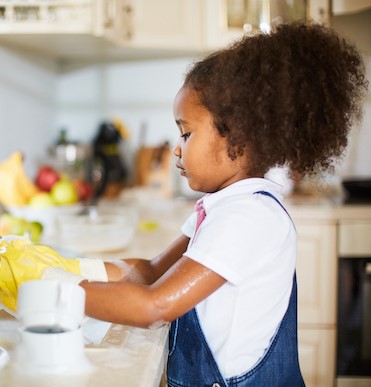
Even toddlers can take responsibility, and they will love it -- if we're patient. With kids of any age, if we see responsibility as empowering
them, instead of burdening them, they will enjoy the learning and the contribution.
So instead of seeing these tasks as "assignments" that your child is sent to do, see them -- at least to begin -- as bonding opportunities. Do them WITH your child so your child enjoys them and WANTS to do them. I know that what you really want is help around the house. And that will happen, eventually. But for a long time prior to that, chores will take MORE of your time as you and your child do them together.
Here's why this strategy is worth it: Instead of kids avoiding their chores or fighting with you about them, they will create a positive habit, enjoying how wonderful it feels to contribute to the family, to master a challenge, to demonstrate competence. All because they start by experiencing chores as a bonding experience with you!
The list below will give you a frame of reference, but obviously, you'll need to adapt this chart to your own child and your family circumstances. Remember to slowly build the degree of freedom and responsibility you offer your child, giving them as much help as they need to handle each level until they master it comfortably. Each section covers a number of years; children in the lowest ages of that range are just beginning to handle the listed items.
Notice that these lists focus on your child's span of control, rather than on tasks you want them to do. There's a reason for that. When you focus on a list of tasks your child "should" do, you end up creating power struggles. "By now you should be able to clean up your own toys!" If, instead, you focus on helping your child take charge of his life, and support him as necessary to learn each new skill, your child wants to step into each new responsibility. Instead of your "holding him responsible," he becomes motivated to take responsibility for himself. It's a subtle shift, but it makes all the difference in the world.
And please don't miss the article on How to Raise a Responsible Child , with 15 everyday strategies guaranteed
to increase your kids’ “response-ability” quotient.
Responsibilities Toddlers can be in charge of:
- Their own bodies, within the limits of safety and decency.
- Cleaning up their own messes. (“That’s ok. Get the paper towels off the counter and let’s clean that milk up. We always clean up our own messes. Don't worry; I'll help.”)
- What to wear (within the limits of appropriate season, safety, and decency.)
- Amount of food to eat (You provide the healthy selection. They decide how much.)
- Getting the food into their mouths. (Unless they ask for your help.)
- What book to read, even if you're reading to them.
- What toys to play with.
- What toys to share (others get put away before friends arrive).
- Cleaning up toys (working with you.)
- When to use the potty. (You offer: “Do you need to use the potty before we leave the house?” But they need to check in with their own body and get to know its signals. Unless you want to be in charge of their toileting for years to come?)
- Sorting and loading laundry.
- Washing surfaces (floors, tables, bathtubs).
Responsibilities Preschoolers (3-5) can be in charge of:
All of the above, plus:
- Their own clothes (Choosing them, within your parameters. Maintaining them, by keeping them in reasonably neat piles by category.)
- Their own rooms (within reasonable neatness parameters. They decide what they want on the walls, within reasonable limits. Parents will need to help them organize their stuff and work with them to clean up.)
- How much to eat.
- What to eat (within appropriate nutritional guidelines. This only works if you limit accessibility of junk food. It does mean you have to decide what to do when they don't like what you've fixed for dinner. In our house, they can get a plain yogurt if they want. Yogurts rarely win out.)
- Who to play with and when.
- Whether to attend social events to which she is invited (excluding mandatory family events.)
- Who is allowed in his room at various times.
- Setting the table.
- Clearing their place from the table.
Responsibilities School-Age Children (6 to 9) can be in charge of:
All of the above, plus:
- How to wear their hair (within appropriate grooming standards).
- How to spend their allowance.
- Completing their homework.
- Getting their school backpack ready the night before.
- How to spend their time (after basic responsibilities like homework are accomplished.)
- Whether to play an instrument or take a class.
- What sport or physical activity to engage in (Given the research on this, physical activity in our house is non-negotiable, but they get to choose the type.)
- Fixing simple food for themselves for snacks and lunch.
- Help make the family contributions for the class bake sale and other events.
- Feed pets.
- Help fix meals.
- Help empty and load dishwasher.
- Help make lists and pack suitcases for trips.
- Help grocery shop.
- Fold own laundry
Responsibilities Preteens & Tweens (10-12) can be in charge of:
All of the above, plus:
- Packing their school lunch.
- Self-grooming: nails, hair, etc.
- Walk with a friend from one point to another within the neighborhood as long as a parent always knows where they are. (This is the first reason that a child needs a cell phone.)
- Stay alone in the house, with certain rules about who can be with them.
- Do their own laundry (eliminates you feeling like the maid when they suddenly need a certain item.)
- Mow the lawn; garden.
Responsibilities Early Adolescents (13-15) can be in charge of:
All of the above, plus:
- Get themselves up in the morning (you may need to be the backup plan.)
- Temporary changes in appearance (i.e., permanent tattoos are out in my family till they’re eighteen, but temporary ones are their choice. Piercings are discussed on an as-requested basis.)
- Ride the bus and subway.
- Go to movies with friends.
- Earn spending money by babysitting or other jobs.
- Budget their own spending.
- Babysit younger siblings.
Recommended Resources
PLEASE NOTE: These books are Amazon links with photos of the books. If you are not seeing them on your page, it may be that your browser is not picking them up, or Ad Blocker in Chrome is blocking the Amazon links. You can disable Ad Blocker just for this site if you like. Or you may want to try another browser. Enjoy!







